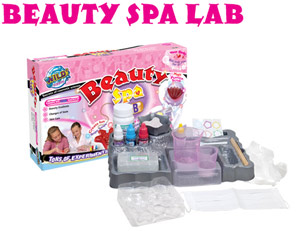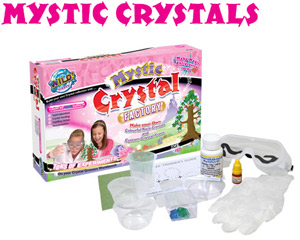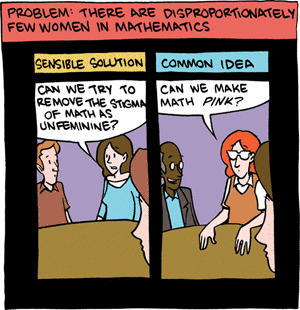Teaching kids about science is one of the best things we can do. Children are naturally inquisitive and curious; and the methods of science, if taught correctly, can be used to engender a lifelong love of these traits.
So I’m happy when science is encouraged for kids. Still, there are times when I see examples of science education that make me cringe, and shake my head, wondering “What were they thinking?”
Enter WILD! Science. This is an apparently successful Australian company that sells science kits for kids. That’s great, and some of the kits look pretty good.
The problem is, they split some of the kits into ones for boys, and ones for girls. And that split is exactly what you think.
 For example, for boys: Hyperlauncher, Joke Soap, Perils of the Deep, Weird Slime Lab.
For example, for boys: Hyperlauncher, Joke Soap, Perils of the Deep, Weird Slime Lab.
For girls: Mystic Crystals, Beauty Spa Lab, Luxury Soap Lab, Perfect Perfume Lab.
Oh: I’ll add that the boys’ kits are marketed in blue; the girls’ in pink.
Um. Yeah.
Now, I am not a sociologist or a psychologist who studies gender roles and the differences between the sexes. It strikes me that there may be no need to separate the way we teach between boys and girls – my friend and geologist Evelyn Mervine discusses this point further – but I’ll also readily admit that there may very well be differences between the ways boys and girls see the world. If that’s the case, I have no problem with a company, teacher, or parent accepting that and using it to help the child learn. In other words, science is the same for everyone, but how we get people interested in it and learning about may vary from demographic to demographic.
But I don’t think that’s really the issue here. The problem here is these girls’ kits all are almost entirely marketed on the idea that girls should be pretty, or should try to make themselves pretty.
As Janet Stemwedel wrote on the Scientific American blog, “Packaging ‘science for girls’ this way is likely to teach girls as much about societal expectations as about science.” She writes more on this topic as well.
 Now, the use of pink for girls and blue for boys makes me squirm a bit, but I’m unsure how bad it is; people give me grief for having a pink iPad cover (and a dress shirt I used to have too, for that matter), and it gives me a chance to mock them for buying into outdated stereotypes. I like pink. So long term problems due to pink/blue color use may be arguable.
Now, the use of pink for girls and blue for boys makes me squirm a bit, but I’m unsure how bad it is; people give me grief for having a pink iPad cover (and a dress shirt I used to have too, for that matter), and it gives me a chance to mock them for buying into outdated stereotypes. I like pink. So long term problems due to pink/blue color use may be arguable.
But the other aspects of this are more troubling. There is a line here, and in my opinion some of these products have crossed it. It seems to me that the marketing of the science of beauty to girls in this way reinforces the damaging stereotype that girls need to be pretty. What makes it worse is that this is a science kit. Science as a field of work is already rife with sexism and stereotyping, where women have to deal with all manners of difficult situations in their careers and daily lives as scientists. Marketing kits like this doesn’t help.
And why do they feel the need to advertise crystals as “mystic”? Because girls like unicorns and magic? This to me is the antithesis of science, and in direct opposition to the very concepts they’re trying to teach.
Again, let me state that I think this company is trying to do a good thing – encouraging kids to get into science – and I’m sure their heart is in the right place… but I think this is very much the wrong way to do it. What this does is reinforce stereotypes and gender roles that are outdated at best.
 In a way, it’s the off-handed nature of the splitting of these kits into genders that is so disheartening. It’s as if this is not worth mentioning, so natural that of course it’s done this way. It holds up a mirror to a greater perception of women’s roles in science and society. Zach Weiner made this point brilliantly, as usual, in one of his Saturday Morning Breakfast Cereal comics.
In a way, it’s the off-handed nature of the splitting of these kits into genders that is so disheartening. It’s as if this is not worth mentioning, so natural that of course it’s done this way. It holds up a mirror to a greater perception of women’s roles in science and society. Zach Weiner made this point brilliantly, as usual, in one of his Saturday Morning Breakfast Cereal comics.
Of course, I’m a bearded, balding, middle-aged white male, which makes me the definition of the median of the bell curve when it comes to science stereotypes. And that’s why I got a kick out of this comment by Mandy Moon, who wrote it on Ed Yong’s original Google+ post about these science kits:
You know, my lab has six women and one man. All of our benches are pink, as is our glassware, our culture plates, our formalin, our BSL-3 waste, our biohazard bags- you name it. Oh, and our ELISA plates show a pink color change in presence of the pretty antibodies we’re seeking. We also wear high heels and white lab coats with little white science skirts. ‘Cause that’s how us girls do science.
THIS.
Note: If you feel strongly enough about this to contact the company, I would ask you to be polite. I understand the urge to be snarky, but I don’t think that will help – leaving a comment on a blog is one thing, directly contacting a company is another. The best possible outcome from all of this is for the company to see that they need to change the way they market science to kids, and that’s best done through persuasion, not vitriol.
Tip o’ the pink lab coat to Ed Yong on Google+. I reshared his link on G+, and the comments are interesting there as well. Thanks to Nate Woods for reminding me about the SMBC cartoon linked above.